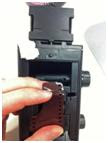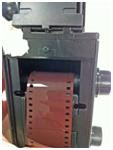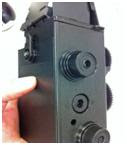how to:

The Recesky TLR is a “do-it-yourself” DIY or build it yourself camera. Not only that, it is a Twin Lens Camera – meaning that there is two lenses of the same focal length. One lens acts as the photographic lens (it takes the picture), whilst the other lens acts as the viewfinder lens (lets you see the picture).
Building the Recesky TLR is not as hard as it first appears – but it sure is great fun!
The first thing you notice when you look at the package the Recesky comes in is that it says assembly time is 1 hours. Without experience, the task may take from anywhere between 1 – 3 hours taking into consideration the time that’s needed to absorb all the information required in piecing together every step!
We hope this tutorial we have written here can be used to assist you in figuring out this puzzle and building process.
Note:The guide is meant to be read as an accompaniment to the instruction manual.
Before you start, remember these few important points:
• Take your time! Remember once you break something, there is no going back. Patience is the key. The parts are well constructed and are very solid, but if you find you are using excessive force in any of the steps then you are most likely doing something incorrectly!
• It is best to read ahead – or at least read what’s involved in the following steps and procedures as there are some sections that may appear out of order in the manual.
• As the camera body and parts are made of plastic, avoid tightening the screws too much in the beginning – tighten the screws only when adjoining and affected parts are firmly in place.
• Keep an eye out on the type of screw used in different sections – there are 3 types of screws used – rounded head (18 screws), flat head (2 screws) and capped head (5 screws).
• In some parts of the instruction manual it mentions an ‘accessory screwdriver’ – but the Recesky kit does NOT come with a screwdriver (the instructions may be possibly copied directly from the Gakkenflex kit – which is a more expensive kit sold in Japan as part of a magazine), so you’ll need to find a small screwdriver to build the camera. If possible, use a screwdriver with a magnetic tip – it will save you a lot of frustration if you need to undo a screw and it gets stuck inside the camera.
Without further ado, here is a step by step commentary on the instruction manual.
1. Assembling the Right Panel of the Body
The first step is pretty straightforward. Use the rounded head screws to secure the nut and triangular screw hole onto the right panel. At the end of this step the right panel should look like this:

2. Assembling the Left Panel of the Body
When assembling the left panel, take note of the order the parts are put together. During step 2, you will be using one of the cap screws to secure the counter, spring A and counter knob together onto the panel. The other screws used are the rounded head screws.
At the end of this step the left panel should look like this:


3. Installing the Front Panel and Shutter Assembly
This is one of the most important parts in assembling the camera! When putting together the shutter assembly, you will be using the two flat head screws that came in the box – this is important to ensure the shutter works as it should.
Fixing spring ‘B’ onto the shutter panel can be a little tricky – when it is fixed in place it should look something like this, secured with a cap screw:

Take note of the difference between spring ‘C’ and spring ‘D’ – they are orientated differently for the different parts of the shutter assembly NOTE: spring C and spring D is incorrectly mislabelled in the English instructions!. The easiest way to tell the dfiference, is by looking at these pictures. With spring ‘D’ fixed in place with a cap screw with a 1mm gap to the transmission lever, it should look something like this:


When spring ‘C’ is fixed in place, it should look like this:

When all parts are in place, you can tighten the cap screw for the transmission lever – don’t fix the screw in too tightly as it will cause the shutter to stick! You will know it is the correct tension when you can hear a crisp shutter ‘click’ when you test the shutter lever. Adjust the screws until you can see the shutter opening and closing smoothly every time you push down the shutter lever.
The finished shutter assembly should look like this:


The camera obscura assembly is fixed by two rounded head screws and a cap screw, and should look like this when secured:


4. Assembling the Inside Cover
The inside cover is another straightforward step – simply fix the back panel onto the bottom panel using rounded head screws and the hook with a cap screw. The assembled inside cover should look something like this (note: the kit we used had one cap screw missing but an extra rounded head screw – we used it with no issues).

5. Camera Body Assembly
Assembling all the separate pieces you have constructed so far to form the camera body can be a little tricky – just follow the instructions in the manual with patience. The key is not to secure any screws too tightly at the beginning – as doing so gives the material less flexibility and less room for movement and adjustment.
Firstly, fix the left and right side panels to the front panel using 6 rounded head screws.


Stick the mirror surface onto the lens fixed panel carefully using the double sided tape provided. The adhesive tape they used can be a little hard to peel off – but take some time to find both sides of the adhesive! Leave the plastic film on the front face of the mirror on until the fixed panel is secured into the camera body. When fixed in place, peel the two layers of protective film off the mirror – this should give you a smooth mirror surface like the one shown:


To put the film transmission axis in place, the side panel needs to be slightly flexible to give a little gap for it to fit. Insert the side of the nib first – and rotate the clickwheel until the transmission axis fits in place.


The same goes for the inside cover – the two side panels need to remain slightly flexible to let the nibs fit through.

Overall, fitting all the parts together for this step can be tricky and may require unscrewing and rescrewing some screws until you find the right flexibility level to do the job. After all the parts are in place, the screws can be securely tightened!
6. Viewfinder Assembly
To assemble the viewfinder, firstly fit the screen panel to the top cover. The screen panel material is quite hard, so it takes a bit of effort to get it in – patience is the key to avoid scratching the screen!


Putting together the viewfinder bracket is quite simple – just remember to put them in order as mentioned in the instruction manual.

Finally, fix the side panels with 2 rounded head screws

7. Lens Assembly
This is another critical part in assembling the camera as this will determine whether your photos will turn out right. When putting together the lens assembly, take great care to confirm the direction the lens is fitted into the lens frame, and not to touch the surface of the lenses!
When the lenses are secured in the lens frames, screw both frames onto the camera body at the same time, making sure the photographic lens frame (the one with the smaller hole) is on the bottom, and the viewfinder lens frame (the one with the bigger hole) is on top. The frames should be tightened until it reaches the end of the opening.

And that’s it… Congratulations! Your baby is ready for shooting – all that’s left is to load a roll of 35mm film!




































